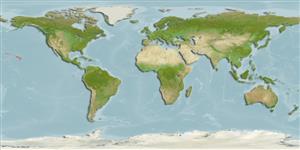Actinopterygii (ray-finned fishes) >
Anguilliformes (Eels and morays) >
Ophichthidae (Snake eels) > Ophichthinae
Etymology: Callechelys: Greek, kalos, kallos = beautiful + Greek, enchelys, -yos = eel (Ref. 45335).
Environment / Climate / Range
Ecology
Marine; demersal; depth range 4 - 24 m (Ref. 58302). Tropical, preferred ?
Pacific Ocean: known only from the Hawaiian Islands, Midway Island and French Frigate Shoals.
Size / Weight / Age
Maturity: Lm ? range ? - ? cm
Max length : 104 cm TL male/unsexed; (Ref. 27478)
Benthic (Ref. 58302). Adults of most Callechelys spend most of their lives within the sediment and do not form permanent burrows. This species is exceptional and has on rare occasions been dip-netted beneath lights at the sea surface at night and has been seen encountered with its head protruding from the sand by divers at various Hawaiian locations (Ref. 27478).
Life cycle and mating behavior
Maturity | Reproduction | Spawning | Eggs | Fecundity | Larvae
McCosker, J.E., 1998. A revision of the snake-eel genus Callechelys (Anguilliformes: Ophichthidae) with the description of two new Indo-Pacific species and a new Callechelyin genus. Proc. Calif. Acad. Sci. 50(7):185-215. (Ref. 27478)
IUCN Red List Status (Ref. 115185)
CITES (Ref. 94142)
Not Evaluated
Threat to humans
Harmless
Human uses
More information
Common namesSynonymsMetabolismPredatorsEcotoxicologyReproductionMaturitySpawningFecundityEggsEgg development
Age/Size
Growth
Length-weight
Length-length
Length-frequencies
Morphometrics
Morphology
Larvae
Larval dynamics
Recruitment
Abundance
ReferencesAquacultureAquaculture profileStrainsGeneticsAllele frequenciesHeritabilityDiseasesProcessingMass conversion
Tools
Special reports
Download XML
Internet sources
Estimates of some properties based on models
Phylogenetic diversity index (Ref.
82805): PD
50 = 0.5000 [Uniqueness, from 0.5 = low to 2.0 = high].
Bayesian length-weight: a=0.00151 (0.00061 - 0.00373), b=2.91 (2.70 - 3.12), in cm Total Length, based on LWR estimates for this (Sub)family-body shape (Ref.
93245).
Trophic Level (Ref.
69278): 3.9 ±0.6 se; Based on size and trophs of closest relatives
Resilience (Ref.
69278): Medium, minimum population doubling time 1.4 - 4.4 years (Preliminary K or Fecundity.).
Vulnerability (Ref.
59153): Moderate to high vulnerability (48 of 100) .
